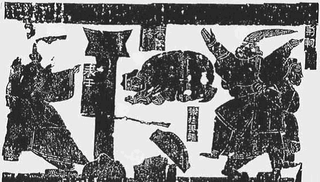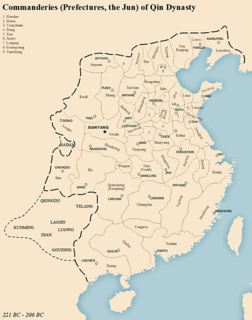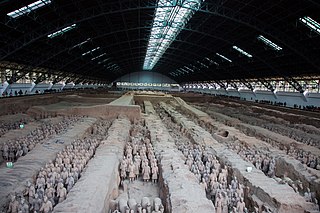 W
WQin Shi Huang was the founder of the Qin dynasty and the first emperor of a unified China. From 247 to 221 BC he was Zheng, King of Qin. He became China's first emperor when he was 38 after the Qin had conquered all of the other Warring States and unified all of China in 221 BC. Rather than maintain the title of "king" borne by the previous Shang and Zhou rulers, he ruled as the First Emperor (始皇帝) of the Qin dynasty from 221 BC to 210 BC. His self-invented title "emperor" would continue to be borne by Chinese rulers for the next two millennia.
 W
WThe Burning of books and burying of scholars refers to the supposed burning of texts in 213 BCE and live burial of 460 Confucian scholars in 212 BCE by the Chinese emperor Qin Shi Huang of the Qin dynasty. This was alleged to have destroyed philosophical treatises of the Hundred Schools of Thought, with the goal of strengthening the official Qin governing philosophy of Legalism.
 W
WThe Epang Palace (E-pang Palace; also Ebang Palace; simplified Chinese: 阿房宫; traditional Chinese: 阿房宮; pinyin: Ēpánggōng; Wade–Giles: E1-p'ang2-kung1) in western Xi’an, Shaanxi Province, China, was a palace complex of Qin Shi Huang, emperor of China. Construction of the palace began in 212 BC. With the exception of its front hall, it was never completed according to findings by Chinese archaeologists.
 W
WThe Great Wall of China is the collective name of a series of fortification systems generally built across the historical northern borders of China to protect and consolidate territories of Chinese states and empires against various nomadic groups of the steppe and their polities. Several walls were being built from as early as the 7th century BC by ancient Chinese states; selective stretches were later joined together by Qin Shi Huang (220–206 BC), the first emperor of China. Little of the Qin wall remains. Later on, many successive dynasties have built and maintained multiple stretches of border walls. The most well-known sections of the wall were built by the Ming dynasty (1368–1644).
 W
WJing Ke was a retainer of Crown Prince Dan of the Yan state. He made a failed assassination attempt of King Zheng of the Qin state, who later became Qin Shi Huang, China's first emperor. His story is told in the chapter entitled Biographies of Assassins (刺客列傳) in Sima Qian's Records of the Grand Historian.
 W
WLi Si was a Chinese calligrapher, philosopher, politician, and writer of the Qin dynasty. He served as Chancellor from 246–208 BC under two rulers: Qin Shi Huang, the king of the Qin state and later the First Emperor of the Qin dynasty; and Qin Er Shi, Qin Shi Huang's eighteenth son and the Second Emperor. Concerning administrative methods, Li Si "indicated that he admired and utilized the ideas of Shen Buhai", repeatedly referring to the technique of Shen Buhai and Han Fei, but regarding law followed Shang Yang.
 W
WThe Mausoleum of the First Qin Emperor is located in Lintong District, Xi'an, Shaanxi province of China. This mausoleum was constructed over 38 years, from 246 to 208 BC, and is situated underneath a 76-meter-tall tomb mound shaped like a truncated pyramid. The layout of the mausoleum is modeled on the Qin capital Xianyang, divided into inner and outer cities. The circumference of the inner city is 2.5 km and the outer is 6.3 km. The tomb is located in the southwest of the inner city and faces east. The main tomb chamber housing the coffin and burial artifacts is the core of the architectural complex of the mausoleum.
 W
WThe Qin bronze chariot refers to a set of two Qin dynasty bronze model chariots that were unearthed in 1980 at the Mausoleum of the First Qin Emperor, Qin Shi Huang. When the models were found they were in many broken pieces, and it took five years to restore them both. Both models are about half life-size.
 W
WAs trade was an important source of wealth for the Yue tribes of coastal China, the region south of the Yangtze River attracted the attention of Emperor Qin Shi Huang, and he undertook a series of military campaigns to conquer it. Lured by its temperate climate, fertile fields, maritime trade routes, relative security from warring factions to the west and northwest, and access to luxury tropical products from Southeast Asia, the emperor sent armies to conquer the Yue kingdoms in 221 BC. Military expeditions against the region were dispatched between 221 and 214 BC. It would take five successive military excursions before the Qin finally defeated the Yue in 214 BC.
 W
WThe Qin dynasty or Ch'in dynasty was the first dynasty of Imperial China, lasting from 221 to 206 BC. Named for its heartland in Qin state, the dynasty was founded by Qin Shi Huang, the First Emperor of Qin. The strength of the Qin state was greatly increased by the Legalist reforms of Shang Yang in the fourth century BC, during the Warring States period. In the mid and late third century BC, the Qin state carried out a series of swift conquests, first ending the powerless Zhou dynasty and eventually conquering the other six of the Seven Warring States. Its 15 years was the shortest major dynasty in Chinese history, consisting of only two emperors, but inaugurated an imperial system that lasted from 221 BC, with interruption and adaptation, until 1912 AD.
 W
WThe Mausoleum of the First Qin Emperor is located in Lintong District, Xi'an, Shaanxi province of China. This mausoleum was constructed over 38 years, from 246 to 208 BC, and is situated underneath a 76-meter-tall tomb mound shaped like a truncated pyramid. The layout of the mausoleum is modeled on the Qin capital Xianyang, divided into inner and outer cities. The circumference of the inner city is 2.5 km and the outer is 6.3 km. The tomb is located in the southwest of the inner city and faces east. The main tomb chamber housing the coffin and burial artifacts is the core of the architectural complex of the mausoleum.
 W
WQin's wars of unification were a series of military campaigns launched in the late 3rd century BC by the Qin state against the other six major Chinese states — Han, Zhao, Yan, Wei, Chu and Qi. During 247–221 BC, Qin emerged as one of the dominant powers of the very strong and powerful Seven Warring States.
 W
WQin Er Shi was the son of Qin Shi Huang and the second emperor of China's Qin dynasty. He ruled from 210 to 207 BCE.
 W
WQin's wars of unification were a series of military campaigns launched in the late 3rd century BC by the Qin state against the other six major Chinese states — Han, Zhao, Yan, Wei, Chu and Qi. During 247–221 BC, Qin emerged as one of the dominant powers of the very strong and powerful Seven Warring States.
 W
WQin Shi Huang was the founder of the Qin dynasty and the first emperor of a unified China. From 247 to 221 BC he was Zheng, King of Qin. He became China's first emperor when he was 38 after the Qin had conquered all of the other Warring States and unified all of China in 221 BC. Rather than maintain the title of "king" borne by the previous Shang and Zhou rulers, he ruled as the First Emperor (始皇帝) of the Qin dynasty from 221 BC to 210 BC. His self-invented title "emperor" would continue to be borne by Chinese rulers for the next two millennia.
 W
WThe Terracotta Army is a collection of terracotta sculptures depicting the armies of Qin Shi Huang, the first Emperor of China. It is a form of funerary art buried with the emperor in 210–209 BCE with the purpose of protecting the emperor in his afterlife.